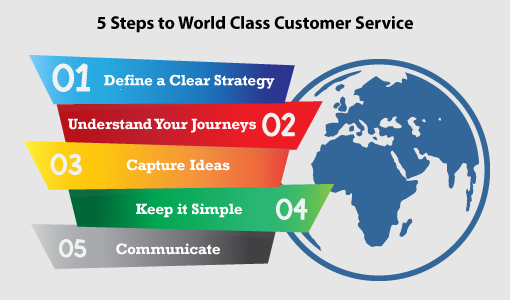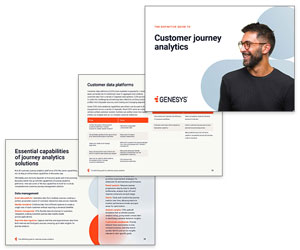In this article, we look at ways that you can deliver world-class customer service.
In our webinar on “How to Be World Class at Customer Service“, Jo Hale from Domestic & General’s contact centre highlighted five steps that are critical to transforming contact centre operations.
So, here we have drilled down on each of these five steps to provide more detail.

STEP 1 – Define a Clear Strategy
Address the Why
One of the key things you have to do is be clear about why you want to make a change. So, if you think about defining the strategy, do you want to be the Rolls Royce or do you want to be a Ford Fiesta (in a good way)?
Be realistic about what would work well in your organisation. Often contact centres will make promises around having great technology and/or a great experience, when they don’t have the resources to provide either.
Once you have a realistic strategy in place, get it sponsored as high as you can go.
Once you have a realistic strategy in place, get it sponsored as high as you can go. So, if you’re lucky enough to have a fabulous CEO who believes in quality of service, you have a fighting chance of getting that service to where you want it to be.
Securing More Resources
If you have a CEO or a board that sees the contact centre as more of a “cost centre” than a “profit centre”, it can be much trickier to secure budget – but not impossible.
There are things that you can do to strengthen your hand when asking for bigger budget. This could include calculating a lifetime value of a single customer to highlight the cost of the issue that you want to be addressed.
Other tactics include calculating the cost of doing nothing and presenting a priority list with analysis of what return on investment (RoI) your strategy would bring to each area of the contact centre.
Now Think What and How
Now you have a justification for why you want to change strategy, it’s time to think about what are you going to do in a way that improves service and works to your budget.
Think about it in terms of what your customers want. What is it that your competitors are doing? Is the technology around you useful to your customers?
Then, make sure you’ve got some real scope of benefit.
It is this attention to detail that is important because you could go for the world, but – in actuality – you may not positively influence the areas than mean the most to your customers. So, thinking about that strategy is quite important.
For more on this topic, read our article: 76 Tips to Improve Your Contact Centre Strategy
STEP 2 – Understand Your Journeys
Map the Customer Journey
There’s an expectation and then there’s the reality of what happens for a customer. When senior leaders listen to calls, they are often surprised because reality is quite different from what they thought was happening.
However, to improve the customer journey, an important step is to understand what is currently going on and what customers are currently expecting of you.
It’s good practice to filter customer expectations into a top 20–25 list and survey customers against these expectations and/or analyse data at each touchpoint.
As further explained in the article “5 Steps to Creating a Customer Journey Map“, it’s good practice to filter customer expectations into a top 20–25 list and survey customers against these expectations and/or analyse data at each touchpoint. This will tell you how far off you are from meeting customer expectations at each touchpoint of the journey.
By doing this, you can identify the gaps between current performance and ideal performance and find out where you need to improve.
Recognise How the Internal Journey Influences the Customer Journey
There are two parts to the customer experience – what the customer can see and what they can’t.

Amy Scott
As Amy Scott of Sedulous Consulting says in the article “Seven Top Tips for Service Design“:
“Think of the customer experience like a theatre, where you can see everything on the front of the stage – the actors, the sets, the costumes. But there are things going on behind the stage – lighting, sound, and scene changes – that will impact your impression of the performance.”
So, when making changes to the internal journey, make sure that you have thought about the knock-on effect this will have on the customer experience, as well as on other departments within the company.
By analysing this internal journey, you may notice some quick internal remedies that will dramatically improve the customer experience.
Concentrate on Moments of Truth
By having an understanding of the customer journey, both inside and out, the contact centre can visualise “moments of truth”.
It is during “moments of truth” when customer expectations are at their highest and, by identifying where these moments lie, your organisation can focus on delivering its best service when it matters most.
At these critical points, it is important to keep analysing data, to ensure that the service provided reflects key brand values. Therefore, measuring customer emotion at these points can be good practice.
STEP 3 – Capture Ideas
Talk to the Team
Ideally, your contact centre should have schemes in place to capture the ideas of your frontline. If we spend time with the agents, we can grow our understanding of the experiences that customers have, but we can also grow our understanding of the experience the team has on a day-to-day basis.
So, try to make sure you run some workshops with advisors in order to understand what’s going on and what customers are saying to them. Then, use that information to help build an experience that you want, for both customers and the team.
Before money is spent on customer focus groups, surveys or even consultants, make sure you have talked to the team.
Many contact centres struggle to identify customer problems but, in many cases, contact centre advisors already know what they are. So, before money is spent on customer focus groups, surveys or even consultants, make sure you have talked to the team.
Harness Their Feedback
In the article “Involve Agents in Operations and Strategy“, we discuss the three keys for harnessing the knowledge of the team. These included:
1. Introduce initiatives that support regular communication with the frontline
Initiatives could include a “you said, we did” scheme or advisor focus groups, or instead you could implement an open-door policy.
2. Engage advisors in exercises that focus on the strategic goals of the business
You could use contact centre walls, wallboards and desktops to display the company strategy (in a vibrant format) or create your own “Dragons’ Den” competition.
3. Nurture good relationships between the contact centre and the wider business
Feedback to marketing which campaigns have elicited a positive/negative response and try to forge a relationship with design, so they use the Voice of the Contact Centre (VoCC) to eliminate frequent design complaints.
While the team is often the place to go to capture ideas of where to improve, site visits – to similar contact centres – are also a great way of picking up proven ideas to boost performance.
Even better than this is to maintain good contact with other contact centres in your business area, if applicable, as if they have implemented an initiative that has proven successful, this can be replicated in your contact centre. After all, you do have the same customer base.
Holding a video meeting every couple of weeks, or visiting them every month, could help to do this.
STEP 4 – Keep It Simple
Don’t Rush Into “Heavy-Duty” Changes
Try not to boil the ocean and do everything at once. Do things bit by bit and first make simple changes, test them, make sure they work and make sure you’ve got feedback loops – so, if it doesn’t work, you’ve learned quickly.
Remember, you don’t have to change every piece of every journey; you could change the bit that makes the biggest difference.
Quite often, we have huge programmes to make these changes, and while they work in principle, it is some of the little things make the biggest difference.
Things like recognising an advisor’s great service can make such a difference, culturally, which – in turn – helps to improve the customer journey.
So, things like recognising an advisor’s great service can make such a difference, culturally, which – in turn – helps to improve the customer journey. Just remember to keep it simple, keep it focused, iterate and learn.
Three Simple and Quick Tips to Boost Contact Centre Performance
It is important to look for simple solutions first, before looking to make big investments to improve customer service and other parts of the customer journey.
1. Focus on Reducing Repeat Contacts
A key part of improving performance is reducing contact volumes. While many contact centres rush into technology like self-service for this, taking your top four or five contact reasons and discussing with the team how you can reduce traffic for each is an important first step.
2. Train Advisors to Smile on the Phone and Teach Good Posture
Basics, such as sounding friendly on the phone, should not be forgotten. Simply asking advisors to smile while talking can help to achieve this, and teaching correct posture has also been linked to building rapport, as well as improving productivity.
3. Think About Allowing Dogs Into the Contact Centre
There have been numerous reports that allowing dogs in the workplace enhances performance, by helping to relieve stress, boost morale and improve communication.
To find out more examples like this, try reading our article: 31 Quick-Fire Tips: How to Improve Customer Satisfaction
STEP 5 – Communicate
Engage Your Team Across the Business
If you are going to be world class, be clear about what world class means and make sure that you share that internally and externally.
In step three, we discussed the importance of talking with the team, but to engage them requires more than this. If you are going to be world class, be clear about what world class means and make sure that you share that internally and externally, celebrating each bit of that success as you go along.
Show that passion for world-class customer service, because getting to be renowned that world-class service can take you a while. So, be passionate about it, and a key part of this is in empowering your teams and involving them and making sure they have a voice.
Involve the team in decisions that have an impact on them, get advisors involved in other areas of contact centre operations (e.g. recruitment) and consider letting the team set their own goals.
For more on this topic, read our article: 5 Ways to Empower Your Agents
Creating a Network Judgement Culture
As highlighted in our article “What Is the Best Model for Contact Centre Culture?” there are three main types of contact centre culture. These are:
Adherence Cultures – Where advisors primarily rely on company policies and procedures to make decisions.
Individual-Judgement Cultures – Where advisors primarily rely on their own judgement and personal experience to make decisions.
Network-Judgement Cultures – Where advisors rely on guidance from other members of the team to make decisions.
This final culture is the culture of world-class contact centres, as decisions are being based on the collective wisdom of the team, meaning that they are the most informed choices.

Jo Hale
Backing up this statement is the finding that the network-judgement culture is 50% better than the other two culture types in terms of customer effort, customer satisfaction and productivity, according to The Harvard Business Review.
Creating this culture is central to world-class customer service because of the new kinds of calls that are entering the contact centre all the time. Empowering advisors to answer these queries using the collective wisdom of the contact centre would seem to be the best way of responding.
What do you think of these five steps? Are there any others that you would add?
Please share your thoughts in an email to Call Centre Helper.
Author: Robyn Coppell
Published On: 9th May 2018 - Last modified: 14th Aug 2025
Read more about - Customer Service Strategy, Communication Skills, Customer Journey, Editor's Picks, Jo Hale, Performance Management, Service Strategy, Team Management



















